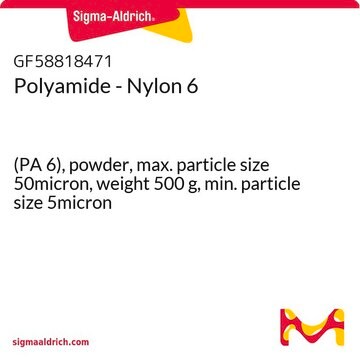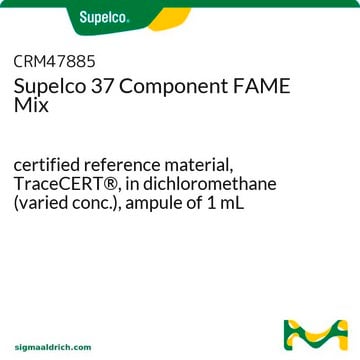The purity of this product can be roughly calculated from the phosphorus content (on a dried basis) and the sodium number provided on the Certificate of Analysis (COA). The minimum specification for purity is > 79% on a dried basis. To prepare a stock solution of this product, it is suggested to dry the product (e.g. 100°C overnight) to thoroughly remove the water of hydration, then accurately weigh the desired amount of the dried phytic acid sodium salt, then add a specific volume of distilled or deionized water to the weighed compound, finally stir the solution until the phytic acid sodium salt is completely dissolved.
Wichtige Dokumente
P8810
Phytinsäure Natriumsalz Hydrat
from rice
Synonym(e):
myo-Inosit-hexakis-(dihydrogenphosphat), Inositol-hexakisphosphat, Inositol-hexaphosphorsäure, InsP6
Größe auswählen
Größe auswählen
About This Item
Empfohlene Produkte
Biologische Quelle
rice
Form
powder
Zusammensetzung
Sodium (Na), ≥5 mol/mol
Löslichkeit
water: soluble
Kationenspuren
Ca: ≤2%
Lagertemp.
room temp
SMILES String
[Na+].[Na+].[Na+].[Na+].[Na+].[Na+].[Na+].[Na+].[Na+].[Na+].[Na+].[Na+].[O-]P([O-])(=O)O[C@H]1[C@H](OP([O-])([O-])=O)[C@H](OP([O-])([O-])=O)[C@H](OP([O-])([O-])=O)[C@@H](OP([O-])([O-])=O)[C@@H]1OP([O-])([O-])=O
InChI
1S/C6H18O24P6.12Na/c7-31(8,9)25-1-2(26-32(10,11)12)4(28-34(16,17)18)6(30-36(22,23)24)5(29-35(19,20)21)3(1)27-33(13,14)15;;;;;;;;;;;;/h1-6H,(H2,7,8,9)(H2,10,11,12)(H2,13,14,15)(H2,16,17,18)(H2,19,20,21)(H2,22,23,24);;;;;;;;;;;;/q;12*+1/p-12
InChIKey
KETSPIPODMGOEJ-UHFFFAOYSA-B
Suchen Sie nach ähnlichen Produkten? Aufrufen Leitfaden zum Produktvergleich
Allgemeine Beschreibung
Anwendung
Biochem./physiol. Wirkung
Hinweis zur Analyse
Sonstige Hinweise
Lagerklassenschlüssel
13 - Non Combustible Solids
WGK
WGK 3
Flammpunkt (°F)
Not applicable
Flammpunkt (°C)
Not applicable
Persönliche Schutzausrüstung
Eyeshields, Gloves, type N95 (US)
Hier finden Sie alle aktuellen Versionen:
Analysenzertifikate (COA)
Die passende Version wird nicht angezeigt?
Wenn Sie eine bestimmte Version benötigen, können Sie anhand der Lot- oder Chargennummer nach einem spezifischen Zertifikat suchen.
Besitzen Sie dieses Produkt bereits?
In der Dokumentenbibliothek finden Sie die Dokumentation zu den Produkten, die Sie kürzlich erworben haben.
-
What is the purity percent of phytic acid sodium salt hydrate P8810? How to make stock solution using this?
1 answer-
Helpful?
-
-
How is shipping temperature determined? And how is it related to the product storage temperature?
1 answer-
Products may be shipped at a different temperature than the recommended long-term storage temperature. If the product quality is sensitive to short-term exposure to conditions other than the recommended long-term storage, it will be shipped on wet or dry-ice. If the product quality is NOT affected by short-term exposure to conditions other than the recommended long-term storage, it will be shipped at ambient temperature. As shipping routes are configured for minimum transit times, shipping at ambient temperature helps control shipping costs for our customers. For more information, please refer to the Storage and Transport Conditions document: https://www.sigmaaldrich.com/deepweb/assets/sigmaaldrich/marketing/global/documents/316/622/storage-transport-conditions-mk.pdf
Helpful?
-
-
How can I determine the shelf life / expiration / retest date of this product?
1 answer-
If this product has an expiration or retest date, it will be shown on the Certificate of Analysis (COA, CofA). If there is no retest or expiration date listed on the product's COA, we do not have suitable stability data to determine a shelf life. For these products, the only date on the COA will be the release date; a retest, expiration, or use-by-date will not be displayed.
For all products, we recommend handling per defined conditions as printed in our product literature and website product descriptions. We recommend that products should be routinely inspected by customers to ensure they perform as expected.
For products without retest or expiration dates, our standard warranty of 1 year from the date of shipment is applicable.
For more information, please refer to the Product Dating Information document: https://www.sigmaaldrich.com/deepweb/assets/sigmaaldrich/marketing/global/documents/449/386/product-dating-information-mk.pdfHelpful?
-
-
Hi, I have sodium phytate (lot: BCCF1452). In COA there is a result about phosphorus 22,2% (dried basis). What is that mean? Is that inorganic phosphorus content? If it is not, how can i calculate the inorganic phosphorus content?
1 answer-
The phosphorus value reported in the product Certificate of Analysis is the total amount. Currently, the inorganic phosphorus is not measured. However, historical data indicates that inorganic phosphorus levels are typically < 0.6 %.
Helpful?
-
Active Filters
Unser Team von Wissenschaftlern verfügt über Erfahrung in allen Forschungsbereichen einschließlich Life Science, Materialwissenschaften, chemischer Synthese, Chromatographie, Analytik und vielen mehr..
Setzen Sie sich mit dem technischen Dienst in Verbindung.








